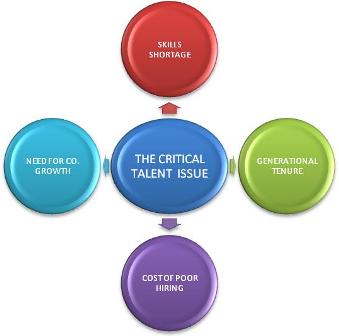 Article In Brief:
Article In Brief:
Rose Voce, Senior Consultant spent some time with the Briscoe team researching the various factors in the market that are leading to a critical talent issue. These are listed in the diagram below. Using some widely accepted statistics on the average time an employee now stays with 1 company, combined with the cost of getting the recruitment of talent wrong can add up quickly – we’ve added it up for you. Finally, we show what a 10% increase in recruitment and retention statistics mean on bottom line costs. Reading time: 1 minute
Here are some sobering facts and opinions that really emphasise just how important it will be to your bottom line, your time and your competitive advantage to acquire the righttalent for your organisation:
SKILLS SHORTAGE
• Western Australia is almost certain to revisit the skilled labour shortages that accompanied the state’s most recent mining boom Commsec “State of the States” report, Jan 2010 – WABN 11th January 2010 • CCI report shows business confidence is the highest it has been in 13 years with 58 per cent of companies expecting WA’s economy to strengthen in the year ahead. WA Business News, 17th December 2009 • Australia needs to dramatically raise productivity if it is to meet the challenges of an ageing population” Kevin Rudd, Jan 19th 2010 • A net 43.1% of employers indicated an intention to increase their permanent staff levels over the January-March 2010 period. WA Business News, 20th Jan 2010
GENERATIONAL TENURE
Tenure is the average period of time an employee will stay with one employer. In 1970, national normative tenure was 12 years. Now it’s 4 years1 . It is predicted that Generation Y’s average tenure is 2.6 years. If your Employee Engagement model retains an employee for an extra year, this now means you will have a 38% Increase in Average Gen Y tenure and a 20% Increase in Employee-wide tenure.
THE COST OF POOR HIRING
Brad Smart, Author of TopGrading is one of the most respected contributors to talent management globally. According to his research, “The approximate cost of a “mishire” is 4.5 times the salary paid”2. This cost includes salary, recruitment costs, disruption costs, training costs, replacement costs and management time.
THE NUMBERS GAME:
Let’s say you manage 100 staff over a 12 year period. On current tenure data, you will recruit 300 times (100 staff every 4 years). If you have a 1 in 2 success rate for finding stars, you will still get it wrong 150 times.
This will cost you $18,000,000 . (Assuming an average salary of $80,000 x 150 poor hires x 4.5 times salary) • If you can increase your success rate by 10%, it will save you $1,800,000 • If you can increase retention by 1 year, often achieved by recruiting a better cultural fit, it will save you 60 recruitment assignments.
It really is time to bring your talent acquisition strategy to the next level.
SOURCES:
1 – Australian Social Research Scott McCrindle Report published on BNET – www.mccrindle.com.au
2 – TopGrading, How Leading Companies win by Hiring, Coaching and Keeping the Best People, Brad Smart, Portfolio Publishing


Follow Briscoe Search